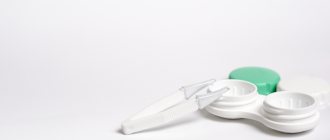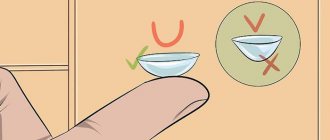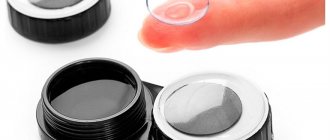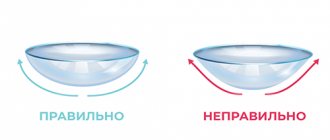Vision correction with contact lenses is a convenient method chosen by many users. However, such optics require care when handling them. It happens that the lens sometimes breaks due to careless movement or is damaged in some other way. What should be done in this case? Is it acceptable to continue wearing one piece?
Contact optics are made from hydrogel and silicone hydrogel polymers - thin, but quite elastic and durable. However, during use, the lenses may become unusable as a result of careless actions, for example, torn. Why might this happen?
The main reasons why lenses break
1. Incorrect putting on and taking off techniques.
The problem arises in patients who have recently switched from glasses to contact lenses. The lens must be removed by pinching the fingertips; it cannot be “picked.” Hands should be washed well. Do not rub your eyes if the lens is uncomfortable, but carefully remove it, make sure there is no mechanical damage or minor dirt, check whether you are putting it on the right side, rinse it with fresh solution and put it on again. Please note that the higher the moisture content in the lens and the shorter the period of its wear, the thinner it is and requires more careful handling during operation.
2. Geometric characteristics are selected incorrectly.
The lens “dangles” and moves during blinking with a large diameter and base curvature, and “sticks” when these parameters are smaller than the actual size of the human eyeball. Before purchasing, have your eye tissue and visual acuity examined by an ophthalmologist.
3. Mechanical damage to the surface.
The products are especially sensitive to sharp objects. Those with long nails are advised to use special tweezers when manipulating lenses. Also, take care of your eyes when working in production where you are in a contaminated room (dust, shavings, sawdust), wear safety glasses.
4. Violation of the wearing regime.
For example, the permissible time spent in traditional daytime (for one year) lenses is about eight hours. After this, the material dries out, the eyes become uncomfortable, redness and a feeling of “sand” occur. During removal, the dried product may stick together, and if you further try to straighten it, it may tear. If such a situation occurs, put a couple of special moisturizers into the eye before removing the lens. Place the stuck lens in a container with saline solution and wait a while before straightening it.
5. Use of contact correction products that have expired or have expired.
Over time, products become fragile, organic deposits accumulate on the surface, and microdamages from dust appear.
6. Marriage.
Occurs when manufacturing technology, storage and transportation conditions are violated. Before you make a purchase, read reviews from patients who have already used these products. Follow your ophthalmologist's recommendations.
Modern manufacturers use exclusively soft and elastic materials to produce lenses. This is required by wearing conditions and direct contact with the sensitive cornea of the eye. Can contact optics break? Why is this happening? And most importantly, what is the right thing to do in such a situation?
They are an excellent alternative to glasses. They are easy to use, invisible to others, and can provide not only central but also peripheral vision. However, they are not without their drawbacks, one of which is the rupture of contact lenses. Of course, such a situation is very unpleasant for any user, because it poses a serious threat to the health of the visual organs. And in order to avoid such a problem, you need to have a complete understanding of why contact lenses break?
Causes of tearing
To prevent damage, you need to be aware of common causes.
Misuse
A popular problem among beginners who decide to replace their glasses. The lens is pulled out using pinching movements of the fingers. You cannot pick them up, wash your hands with soap before removing them. Do not scratch your eyes if discomfort occurs. The lens is carefully removed, inspected, and contamination is detected.
Sometimes people put it on the wrong way. You need to load everything into the storage solution and put it on again. Lenses with high moisture content will last less. They are too soft and tear easily.
Incorrectly selected geometric characteristics
The product dangles when blinking if its diameter is too large. Lenses stick if their width is smaller than the cornea. Before use, the ophthalmologist must examine the patient. The eye tissues are examined and the size of the cornea is determined.
The width of the contact lens increases and its sagittal size increases. As the diameter decreases, the depth decreases.
Violation of the wearing regime
Extended lenses are used for 8 hours. They dry out if you keep them in your eye longer. People feel discomfort, their eyes turn red. It feels like sand has gotten in there. When removed, dried products often stick together. They tear when people try to straighten them with their hands.
We recommend reading: What lenses can you sleep in?
To get the lens out correctly, you need to apply moisturizer to your eyes. The sticky ophthalmic product is sent to a container with saline solution and straightened out after a few hours.
Expired lenses
Fragility increases as the shelf life expires. Small scratches and organic deposits gradually appear on the surface. It is useless to care for them; you need to buy new products. Trying to use expired lenses can lead to irritation. Hard products take longer to use, products with high moisture content deteriorate faster.
Defects in production
Damage for this reason often occurs during use. It is necessary to buy eye optics from trusted manufacturers. Trademarks that have proven themselves well in the market do not make such an oversight. The quality of lenses is compromised during testing or storage. People are trying to purchase affordable products. You cannot skimp on materials that come into direct contact with your eyes.
Why do lenses break? On the issue of quality
The main reason why lenses break is, of course, their poor quality or manufacturing defect. That is why we strongly recommend that you purchase only products from well-known brands that have proven themselves in the optics market. In addition, the quality of contact lenses may be impaired during transportation, as well as due to violation of storage conditions. We often pay attention to an attractive price, lower than the market average. However, we should not forget that these ophthalmic products come into direct contact with the eyes, and in no case should you skimp on their health.
Damage to the edges of the lens when putting it on
The next reason why lenses break is mechanical damage. It is believed that today the thinnest are daily contact lenses, and traditional models, which can be worn for six months or more, are much denser in structure. This is true, but the material used to create them is very soft, and therefore can be damaged by careless movement. Most often, as a rule, the edges of the lens are damaged. Usually girls with long nails face this problem. To avoid damaging the edges of the product, ophthalmologists recommend using special tweezers with silicone tips.
Why do contact lenses break in my eyes?
Another question that worries users is why do lenses tear in their eyes? Such situations are dangerous primarily because tiny particles of the polymer from which the optical products were made may remain under the eyelid. What to do? If you notice that the lenses in your eye are torn, try to understand where exactly the pieces remain. Of course, a person is not always able to determine this visually. In this case, you should rely on tactile sensations. On specialized forums, users note that usually contact lenses that rupture in the eyes move upward. To get their particles, lift your head, gently lift your eyelid with your fingers and try to roll your eyes. If you manage to find any remains, carefully pull them out with tweezers. Otherwise, seek help from a specialist.
What to do if the lens does break?
If you notice that your contact lenses are damaged, you should never wear them. The fact is that the use of such optical products can not only lead to discomfort, manifested in redness and burning, but also cause damage to the cornea of the eye, which will lead to serious consequences in the future. Remember that lenses don't break without reason. As a rule, this is preceded by certain circumstances that we listed above. That is why we recommend that you purchase products from trusted manufacturers, follow the rules for caring for contact lenses and be as careful as possible when using them.
Many people choose vision correction with lenses. Of course, these ophthalmic products have many advantages over glasses. But contact optics require care and compliance with operating rules. Carelessness can lead to, for example, the lens breaking.
These ophthalmic products are made from hydrogel or silicone hydrogel soft polymers, which have sufficient strength and elasticity. But they can still be damaged as a result of careless actions. A common case is lens rupture. Why this can happen and what to do in this situation will be discussed in our article.
Causes of lens damage
- Poor quality optics. Ophthalmologists constantly warn that you should purchase optics only from trusted manufacturers. Lenses of questionable quality, low price or unknown brand should raise suspicion. It's better to refrain from purchasing.
- Violation of operating rules. Improper storage, violation of replacement periods and wearing conditions can lead to the polymer becoming unusable, becoming more fragile and prone to damage.
- Lens drying out. In extremely hot or air-conditioned air, or in windy weather, the material may dehydrate and may tear if handled carelessly.
- Expiration date. Carefully look at the labeling on the packaging. After the expiration date, it is dangerous to use the optics; the polymer loses its elasticity and breaks easily.
Why might the lens break?
The polymer from which contact correction devices are made can be damaged due to several factors:
1. Inadequate quality of optics. This usually happens if the consumer purchases products from unverified manufacturers on the Internet, often these are colored lenses. In pursuit of dubious savings, we often harm our health. The difference between the products of certified global brands and those of an unknown company will be insignificant, but the problems can be global. The low price should immediately alert you. Please read reviews of these products before making a purchase.
2. Often the cause of damage to ophthalmic products can be their improper use. This also includes improper storage, failure to comply with replacement deadlines, violation of the wearing regime, errors in the process of putting on and taking off. When you start using contact optics, you should carefully study the rules for putting them on and taking them off, because this process will have to be carried out twice a day.
3. Drying out the lens in the eye can also lead to its rupture. This happens when it is not hydrated enough. If you have to spend a long time, for example, in a room with dry air, you should stock up on moisturizers.
4. Too sharp or unkempt nails can also cause contact correction devices to rupture. In this case, you should get your nails done regularly to prevent this from happening.
5. Expiration of lenses. Typically, the polymer becomes more brittle and prone to damage.
What to do if the lens breaks?
How can you tell if an optical product is damaged? Make it a rule to carefully inspect them in the light every time before putting them on, even if it is a new pair from a blister pack: no one is protected from manufacturing defects. If even a micro-tear is detected, they should not be used under any circumstances: in addition to a feeling of discomfort, this can lead to irritation of the mucous membrane and cornea, which will cause unpleasant consequences for eye health.
The damaged lens should be thrown away and replaced with a new one. If this was the last pair, then temporarily use glasses, which it doesn’t hurt to have on hand for emergency situations.
Can I wear torn lenses?
It is very difficult to prove that an ophthalmic device was damaged through no fault of the owner. Therefore, it makes no sense to demand compensation and return of the goods.
Violation of the integrity of the structure is a contraindication for further use. If the transparent material is torn off-center, you may not feel any discomfort when wearing the lens. However, a clear picture does not indicate the absence of a negative effect on the cornea. Ophthalmologists note that the torn plate does not adhere correctly to the cornea, affecting visual acuity and the condition of the eye. If you cannot quickly buy another pair, you should temporarily switch to glasses or not overload your eyes. But you cannot wear a damaged lens even for a short period. Typically, tearing of eye corrective products occurs due to the following reasons:
- strong compression with tweezers;
- poor quality material;
- non-compliance with storage and use rules;
- poorly selected vision correcting agent;
- incorrect removal or installation of the plate.
The lens in the eye breaks - what to do?
It also happens that optical products can break while being in front of your eyes. What to do in this case? This often happens when lenses are removed or put on, or when they are not sufficiently moisturized and dry out in hot climates. How can you tell if contact correction devices have broken while being worn? Decreased visibility, a feeling of discomfort, or a sensation of a foreign body when blinking may indicate this. Carefully remove the lens and inspect it.
If the fears are confirmed, then there is some possibility that a few particles of the polymer remain in the eye and can cause inflammation. But don't panic. Nature is unusually wise and has designed our body in such a way that it is able to cleanse itself. This also applies to the organs of vision.
Try to determine where exactly the polymer particles could remain. You can do this by looking in the mirror, or you can determine it tactilely by feeling it with your fingers. As is correct, most often the particles get stuck under the upper eyelid. Pull it back and direct the light to give yourself a good view, or better yet, ask someone to help you do this. If they are visible, try to carefully remove them with thin tweezers, or apply moisturizing drops and blink vigorously to push the pieces out from under the eyelid. You can also lightly push them towards the inner edge of the eye, where they should come out.
What to do if you cannot remove the particles yourself, and you continue to experience discomfort, sensing a foreign body? You should contact an ophthalmologist, who will definitely help you cope with the problem.
What about the cons?
Unfortunately, these also exist. The “easiest” one, so to speak, is that such a correction is not suitable for all patients. Therefore, before purchasing lenses, it is recommended to wear them for a short time just to walk around the city.
. If the eyes “accept” them, great. If you experience discomfort in your eyes, irritation and lacrimation begin (and these symptoms do not go away over time), then contact correction should be abandoned forever.
At the same time, even if the lenses are “accepted” by the eyes, this does not mean that there will be no allergies, irritation or infectious inflammation. After all, a lens is, first of all, a foreign body, and the visual organ is extremely fragile and sensitive.
On a note!
Lenses also need to be removed/put on regularly, and all these manipulations are done, of course, with your fingers.
This procedure can be dangerous, especially for drunk people and children. If you constantly wear lenses, this can cause drying out of the eye (the only danger is that the corrective agent will fall out) and disruption of gas exchange in the cornea (fraught with serious problems). If you wear a torn lens, this can even lead to corneal erosion. If you use a low-quality solution or if you do not remove the lenses at night for some time, corneal edema or the so-called red eye syndrome will appear. In short, there are many problems that can be encountered when wearing contact lenses, but they arise, as a rule, only if they are stored/weared incorrectly.
To avoid such troubles, be sure to listen to the opinion of a qualified doctor.
Video - Lenses or glasses. What to choose?
Preventing contact lens rupture
What can be done to minimize the risk of damage to optical products? Ophthalmologists give some advice on this matter.
1. Use a special accessory - a lens suction cup (usually sold in a lens care kit). This is especially true if you have long and sharp nails. With its help, it will be easy to carry out the procedure of putting on and taking off without damaging the optical product. You can buy a suction cup in any specialized salon or online store.
2. If the lens accidentally gets dry, do not try to straighten it by pulling the stuck edges, because this will definitely damage it. Place it in a container, fill it with fresh solution, and leave it for several hours, after which it should straighten out. Using tweezers, carefully remove from the liquid and inspect for tears. The lens dries out if stored improperly or after the expiration date, so you should be careful.
3. Buy contact correction products only from trusted sellers, do not skimp on your health. The difference between a fake and a quality product will be small, but the problems can be significant. The best option is an online store specializing in the sale of ophthalmic products. Firstly, it presents almost all the necessary products for the care of optics, and secondly, there is no risk of running into a fake: there are products on sale from well-known world brands, about which users leave many reviews on thematic forums.
4. Be attentive to the rules for using contact optics: do not wear it longer than the prescribed period, do not violate the wearing regime, and also store it as it requires: in a container, filled with fresh solution, changing it every day.
5. Use special care products: solutions, deep cleaning systems from well-known manufacturers. There are those who like to make a universal solution themselves from water and salt or hydrogen peroxide. Optical care products are quite affordable; there is no point in saving on them and exposing your eyes to danger.
We hope that our article helped answer the question - what to do if the lens breaks - and understand that only careful adherence to operating rules will make wearing contact optics the safest. We wish you good health!
People with vision problems are simply forced to wear glasses in order to feel comfortable and not feel their deficiency.
In addition to its main function - improving vision, glasses are an accessory that can create a unique and stylish image, bringing novelty and fashionable accents to the appearance. Despite all the positive qualities, glasses have one significant drawback - their fragility. A fall from the nose will most likely damage either the frame or the glass.
Contact lenses can be an excellent alternative to glasses, especially during life situations where damage to glasses can be difficult to avoid, such as active sports or recreation.
How to choose contact lenses? (video)
Pros of contact lenses
Let's start with the fact that thanks to lenses a person can truly see the world differently. After all, glasses, even if they are of the highest quality, distort surrounding objects (in particular, this applies to size). You should also remember about full visibility and fogging of glasses in the cold season (those who wear/have worn glasses know very well what we are talking about). Finally, the lenses allow you to wear sunglasses. In short, there are many advantages.
Sometimes situations arise in which the use of lenses has no other alternative. These could be, for example, serious vision problems for which even the thickest glasses are ineffective. Or if the visual acuity of the eyes is different.
Reasons leading to contact lens rupture
- The main reason is the poor quality of the lenses themselves. Not all manufacturers comply with quality standards when producing contact lenses, but the worst thing is that the end consumer suffers. To avoid stumbling upon low-quality products, you should buy only lenses from trusted manufacturers. An excessively low price should be an alarm bell indicating the low quality of the product and the dishonesty of the manufacturer.
- The second reason is improper use of contact lenses during wear and maintenance. This includes improper storage, non-compliance with wearing periods and errors in the process of removing and putting on lenses. Each contact lens cleaning product contains instructions on the correct process of putting on and removing lenses, which should be memorized in order to be used correctly in practice.
- Another important factor leading to lens rupture can be prolonged wear during the day without additional moisturizing. Excessively dry lens surfaces make them brittle and may cause damage. To avoid such incidents, you should use special eye drops that maintain the required hydration.
If the lens does break
If there is even the slightest suspicion that the lens is torn, even if it is a small crack, under no circumstances should you wear it, because wearing a damaged lens can lead to not only unpleasant sensations and discomfort, but even damage to the iris sclera or cornea, which will lead to serious consequences.
Contact lenses and their care (video)
The lens is torn in the eye, what should I do?
Sometimes there are situations where the lens breaks right in the eye. Most often this happens during the process of removing or putting on contact lenses. In this case, tiny particles of the polymer from which soft contact lenses are made may remain inside the eye, under the eyelid. Under no circumstances should you panic.
Do not forget that nature is unusually wise and has created the human body and the eye in particular in such a way that it is able to clean itself.
If a lens ruptures in your eye, the first thing you should do is try to understand where exactly the pieces of the lens remain. If it is impossible to determine this visually, you must rely on tactile sensations. Most often, the lens moves upward along the eye. It is necessary to raise your head closer to the light to ensure the maximum level of illumination and roll your eye, lifting the eyelid. If you find a piece of debris, you can try to pull it out of the eye with thin tweezers. It is best to put drops in your eyes before the procedure.
If the lens is not located in any way, then you should blink quickly and often to cause active hydration and thus push the stuck pieces to the middle of the eyeball, from where they can be easily removed. Another method, also based on the help of the lacrimal glands, consists of prolonged and concentrated observation of one point until burning and stinging appears in the eyes, which will cause tearing, which will push the lens.
Contact lenses (video)
As many years of practice have shown, contact lenses of proper quality, with proper care and use, almost never break.
Therefore, you should not skimp on your health and approach the selection of “second eyes” with all responsibility and seriousness.
A torn contact lens should be thrown away immediately. Even if a small piece has come off on the side, the lens looks quite decent, and you feel like you can still walk around in it. It is dangerous to wear it! It makes no difference: the SCL is torn in half or its edge is just slightly torn - throw it away without any doubt.
The lens broke - why? Let's look at the main reasons
To avoid contact lens rupture, you need to know when this can happen.
Reason No1. Incorrect operation
A common problem for those who have only recently abandoned glasses in favor of contact lenses. It is necessary to remove the latter using pinching movements with your fingertips, without picking at all. Before doing this, it is important to wash your hands thoroughly with soap. If discomfort occurs, you should not rub your eyes - instead, carefully remove the lens and examine it for dirt or damage, check whether it is on the wrong side, then dip it in a fresh solution and put it on again. It is worth noting that the smaller
the product and the more moisture it contains, the thinner it will be
. Therefore, the more careful you need to handle it.
Reason No2. Incorrect lens geometry
If it moves and “dangles” when blinking, then most likely it has a larger diameter than required. If the dimensions of the lens are smaller than those of the eye, then it will “stick”. For this reason, it is important to have your visual acuity and eye tissue examined by an ophthalmologist before purchasing.
Reason No3. Various types of damage
The products described in the article are characterized by special sensitivity to sharp objects. Therefore, if you have long nails, then it is better to use special tweezers for manipulation. In addition, eyes should be protected in production that involves contaminated premises (this could be sawdust, dust, etc.), preferably with safety glasses.
Reason No4. Non-compliance with wearing regime
For example, you can wear regular annual lenses for no more than 8 hours at a time. After this time, the product dries out, the person begins to experience discomfort, redness and “sand” appear in the eyes. Then, when removed, the dry lens may stick together, and if you try to straighten it, it may even tear.
Note!
To avoid this problem, apply several moisturizing eye drops before removing the product. If the lens is stuck together, place it in a container with fresh water, wait a while and only then try to straighten it.
Table. Instructions for removing a stuck lens.
| Steps, photo | Description of actions |
| Wash your hands thoroughly first, otherwise you risk getting an infection. Try not to wipe your fingertips (with which you will remove the stuck product) with a towel, otherwise small fibers will get into your eyes. | |
| Don't panic - this will make it even more difficult to remove the optical product. You can pause and take a few deep breaths if you are very nervous. Contrary to popular belief, the lens cannot move behind the eye in any way, and does not pose a serious threat to health. | |
| Determine exactly where the lens is located. It’s not difficult to do this – just trust your feelings. As a last resort, you can feel it with your hands, after closing your eye. If none of the methods helped determine the location of the lens, then perhaps it simply fell out. | |
| Place a special solution in your eyes to moisten the lens (it may be stuck because it has dried out). Wait a little, blink a few times and try to get it out again. | |
| If the product is under the eyelid, then you need to close the eye and lightly massage it (the eyelid) with your fingers. Try moving it onto the cornea. | |
| If the lens “fits” correctly, but does not come off, try to remove it not by the traditional method, but by blinking and lightly pressing your finger on the eyelid. This should help. | |
| If the lens is under the eyelid, you need to lift it. You can use a cotton swab. You may also need help from friends or relatives. | |
| If the described methods are ineffective and severe irritation, consult an ophthalmologist. The specialist will be able to remove the lenses without injuring the eye. |
Note!
If you think you have damaged your lens while trying to remove it, visit your doctor as soon as possible! By the way, even if it is successfully removed, it is still better to consult a doctor to check whether the eye was damaged.
Reason No5. Expired products
If your lenses are past their expiration/replacement dates, they may become fragile. Moreover, over time, small scratches from dust appear on the surface, and deposits of organic origin accumulate.
Reason No6. Manufacturing defect, low quality
One of the most common reasons. That is why it is advisable to purchase lenses only from well-known and trusted manufacturers. At the same time, do not forget that the quality of products may be impaired during transportation or storage.
Important!
People are often “deceived” by the lower price, forgetting that the lenses come into direct contact with the eyes, and therefore cannot be saved on them.
Why you shouldn't wear a damaged lens
At the rupture site, the lens has uneven edges that “cling” to the eyelids and injure the cornea. Wearing such an SCL causes a lot of suffering.
Moreover, a torn lens damages the epithelial cells of the cornea, which leads to the appearance of ulcers and even the development of keratitis. All this can result in the formation of a cataract and an irreversible drop in visual acuity.
If your health is important to you, don’t try to save money. Believe me, buying a new product will cost less than treating dangerous complications.











